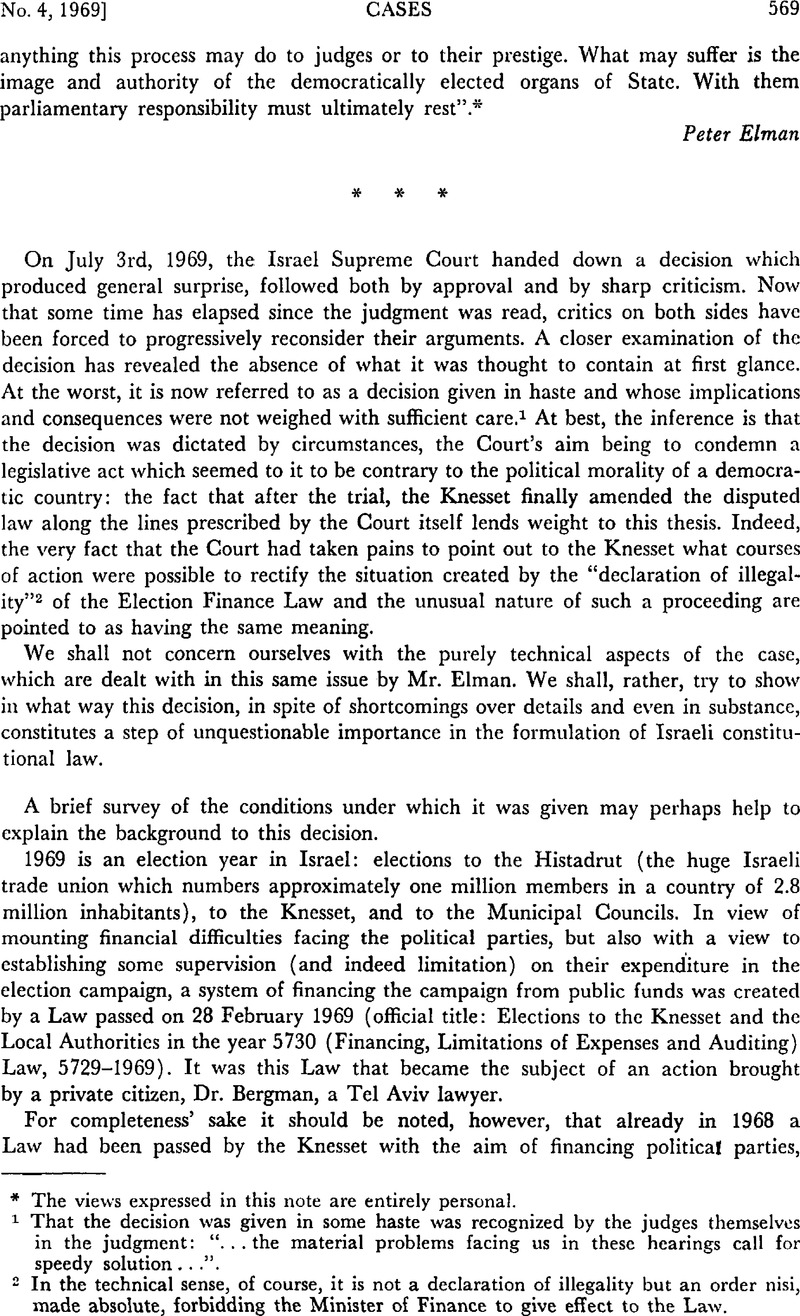Published online by Cambridge University Press: 09 April 2017

1 That the decision was given in some haste was recognized by the judges themselves in the judgment: “…the material problems facing us in these hearings call for speedy solution…”.
2 In the technical sense, of course, it is not a declaration of illegality but an order nisi, made absolute, forbidding the Minister of Finance to give effect to the Law.
3 Cf. criticism of this law by Zamir, I., “The Party Finance Law, 5728–1968” Mishpatim Vol. I, Number 2, pp. 448–462 (in Hebrew).Google Scholar
4 In actual fact the sum of IL. 14,880,000, as a simple multiplication shows, represents more than 120 shares of IL. 120,000 each. This is due to the fact that, certain political groupings having split since the last elections, the Law allots shares to the original grouping according to the number of members it had immediately after the last elections, but allots the shares due to the splinter group in the normal manner. The difference is IL. 480,000, that is, four shares.
5 A second argument had been put forward by the petitioner, but was dismissed straight away by the Court: the petitioner maintained that the right to introduce such a Law should be reserved to the Government, in accordance with the practice in force in the English House of Commons, which provides that members of Parliament cannot initiate legislation which has as its object an increase in expenditure.
6 Elections (Ratification of Validity of Laws) Law 5729–1969: 23 July 1969, Sefer HaHukim No. 568, p. 204.
7 Since the Constitution of 4 October 1958 came into force, the problem is slightly different, since there now exists in France a certain form of supervision of the constitutionality of Laws, reserved to the Constitutional, Council. As far as the Conseil d'Etat is concerned, the situation remains unchanged. Its material lack of jurisdiction in supervision of statutes is duplicated by a lack of jurisdiction resulting from regulations determining areas of jurisdiction. As for the jurisdiction of the old “Constitutional Committee” of the Constitution of 27 October 1946, it was even more limited and somewhat odd, since essentially it implied the subordination of the Constitution to the Law (cf. art. 91 of that Constitution): “…the Constitutional Committee examines whether the Laws voted by the National Assembly imply a revision of the Constitution.”
8 Ha'aretz, weekly supplement: 15 August 1969, No. 47 (298) p. 16 (in Hebrew).
9 Cf. Likhovski, : “The Courts and the legislative supremacy of the Knesset” (1968) 3 Is. L.R. 345Google Scholar; “Can the Knesset Adopt a Constitution which will be the Supreme Law of the Land” (1969) 4 Is.L.R. 61, and Prof. Akzin's reply at p. 170 of the same issue.
10 Cf., e.g., Friedrich, C. J., Constitutional Government and Democracy (New York, 1965) 132–155.Google Scholar
11 For details of this precise problem, compare, besides the articles already cited, Rackman, Emanuel, Israel's Emerging Constitution (New York, 1965Google Scholar); Rubinstein, A., “Israel's Piecemeal Constitution”, XVI Scripta Hierosolmytana (1966) 201Google Scholar; Klinghoffer, Hans, “Die Entstehung des Staates Israel—Eine verfassungs-geschichtliche Darstellung”, Jahrbuch des Oeffentlichen Rechts der Gegenwart Neue Folge, Band 10, pp. 440–484.Google Scholar
12 Besides the articles already cited (Likhovski, Rubinstein…), cf. articles by: Akzin, B. in (1961) 17 HaPraklit 230 (in Hebrew)Google Scholar; Sternberg, M., in (1968) 16 Molad 284 (in Hebrew).Google Scholar